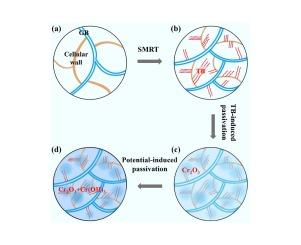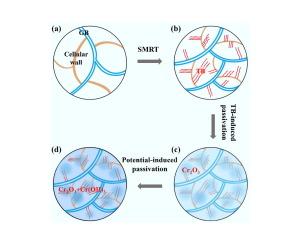燃料电池模拟环境下选择性激光熔化不锈钢表面机械轧制强化腐蚀研究
IF 6.9
2区 材料科学
Q2 CHEMISTRY, PHYSICAL
引用次数: 0
摘要
增材制造的不锈钢(SS)在氢燃料电池的关键部件双极板(BP)的设计和制造中显示出许多特殊的优势。然而,打印样品的腐蚀性能是一个挑战。在本研究中,通过选择性激光熔化(SLM)印刷的奥氏体SS通过表面机械轧制处理(SMRT)进行改性,提高了其耐腐蚀性,使其更适合燃料电池恶劣环境。SMRT后的SLM试样的显微组织由带有纳米孪晶和层错的细晶粒组成。在模拟燃料电池工作环境的电化学测试中,通过动电位极化测试,SLM样品在阳极和阴极环境下的腐蚀电位分别为 − 240和 − 220 mV,而SMRTed样品的腐蚀电位分别为17和23 mV。SMRTed样品的接触角和界面接触电阻测试表明,SMRTed样品具有良好的疏水性和导电性。通过x射线光电子能谱(XPS)对恒电位极化后的腐蚀产物进行了测定,结果表明SMRTed钝化膜中Cr2O3含量高于SLM样品。SMRT产生的纳米孪晶结构促进了更厚的钝化膜的形成,有效地减缓了腐蚀。本文章由计算机程序翻译,如有差异,请以英文原文为准。


Corrosion enhancement of selective laser melted stainless steel by surface mechanical rolling treatment in fuel cell simulated environment
Additively manufactured stainless steel (SS) exhibits many special advantages in the design and fabrication of bipolar plate (BP), which is a key component in hydrogen fuel cells. However, corrosion performance of the printed sample is a challenge. In this work, austenitic SS printed by selective laser melting (SLM) is modified by surface mechanical rolling treatment (SMRT) to enhance the corrosion resistance, making it more suitable for harsh environments of fuel cells. The microstructure of the SLM samples after SMRT is composed of refined grains with nanotwins and stacking faults. In electrochemical tests simulating the operating environments of fuel cell, the corrosion potentials of SLM samples deliver − 240 and − 220 mV in anode and cathode environments through potentiodynamic polarization tests, while those of the SMRTed samples are 17 and 23 mV, respectively. Contact angle and interface contact resistance tests of the SMRTed samples indicate a good hydrophobicity and electrical conductivity. The corrosive products after potentiostatic polarization tests are determined by X-ray photoelectron spectroscopy (XPS), showing that the passivation film of SMRTed sample contains more Cr2O3 than that of SLM sample. The nanotwinned structure produced by SMRT promotes the formation of a thicker passivation film to effectively slow down the corrosion.
求助全文
通过发布文献求助,成功后即可免费获取论文全文。
去求助
来源期刊

Applied Surface Science
工程技术-材料科学:膜
CiteScore
12.50
自引率
7.50%
发文量
3393
审稿时长
67 days
期刊介绍:
Applied Surface Science covers topics contributing to a better understanding of surfaces, interfaces, nanostructures and their applications. The journal is concerned with scientific research on the atomic and molecular level of material properties determined with specific surface analytical techniques and/or computational methods, as well as the processing of such structures.
 求助内容:
求助内容: 应助结果提醒方式:
应助结果提醒方式:


